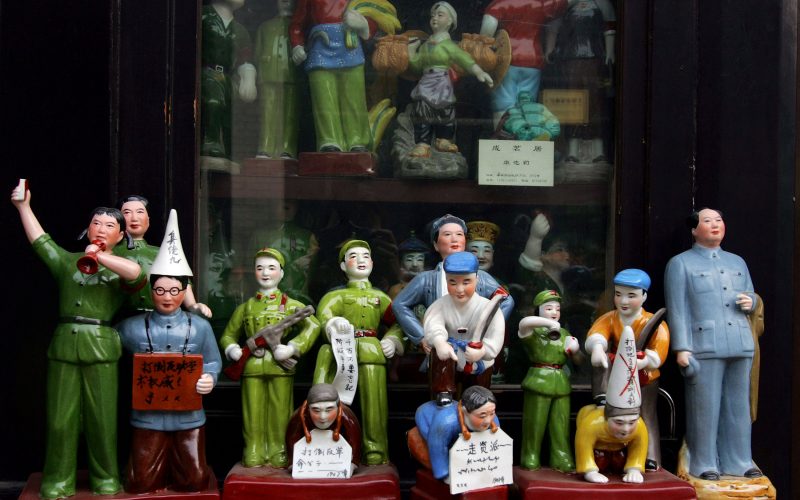
Porcelain figures depicting the Cultural Revolution on a stall in Beijing (AP)
How beating a class enemy became a favourite pastime in the China of Chairman Mao
The Cultural Revolution
by Frank Dikötter, Bloomsbury, £25
The Cultural Revolution in China exploded on Western consciousness in the summer of 1966. It seemed almost incomprehensible that an ancient civilisation which revered tradition, respect for elders and scholarship, and which had accumulated thousands of artefacts of great antiquity, should suddenly set about its own cultural death wish. Yet this is exactly what happened.
This book, written by a historian of modern China and the third in a trilogy about Chairman Mao, explains why and how this appalling 10-year-long period of chaos and barbarity happened. Dikötter writes with the objectivity of an outside observer, but his opinion of Mao is clearly stated at the outset: “Like many dictators, Mao combined grandiose ideas about his own historical destiny with an extraordinary capacity for malice.”
As with Soviet Russia after the Revolution, the book demonstrates the Chinese communist leader’s hatred of the past and his determination to eradicate all traces of the former “bourgeois” culture, from “private thoughts to private markets”. In pursuit of this aim Mao launched his Great Leap Forward, an aggressive policy of collectivisation and industrialisation. It was a complete disaster. Between 1959 and 1962, 45 million Chinese were worked, starved or beaten to death, all to satisfy the whim of a “Stalinist attracted to the … cult of the leader, elimination of private property, control of people’s lives and huge expenditure on national defence”.
By 1966, when it was obvious that the Great Leap Forward had failed, the ageing Mao became desperate to consolidate his own power in the face of the unspoken criticism of his subordinates. His Socialist Education Campaign, a vicious purge during which five million Party members were punished and more than 77,000 people were hounded to death, did not satisfy his paranoia. Knowing the volatility of youth, he decided to unleash his Cultural Revolution, driven by millions of student “Red Guards”, whose twisted, hate-filled features began to be seen in the Western press.
The Red Guards, full of zeal and politically immature, rallied to the cult of their leader, attacking anyone labelled as the enemy: reactionaries, capitalists, bourgeoisie, “rightists” and counter-revolutionaries. On August 18 more than a million young students assembled in Tiananmen Square and were ordered to destroy “all the old ideas, old culture, old customs and old habits of the exploiting classes”. Many horrors resulted and, this being China, on a massive scale: teachers were beaten to death, ancient libraries and monuments destroyed; and cats killed as feline symbols of bourgeois decadence. There were even instances of ritual cannibalism. Dikötter comments that children were often the most vicious: “Beating a class enemy to a pulp became a favourite pastime.”
Their example was followed over the coming years by factory workers. This brought further national disruption. Crime became rampant. Alongside all this, there was the relentless cult of Chairman Mao, by posters, slogans, loudspeakers, the radio, mass rallies and the wholesale production of the Little Red Book. Witnesses spoke of a “ceaseless inferno of sound”.
All this came to an end with the death of Mao in September 1976. Unlike the death of Zhou Enlai of cancer in January of that year, which had caused a spontaneous outburst of grief for the one man who had tried to mitigate the disaster of the Cultural Revolution, there was much feigned sorrow but few real tears.
With the dictator’s death the remnants of Mao Zedong thought were destroyed. It is a tragic and salutary history, well worth knowing.
This article first appeared in the August 19 2016 issue of The Catholic Herald. To read the magazine in full, from anywhere in the world, go here.
